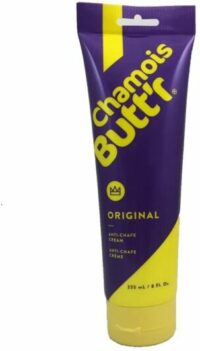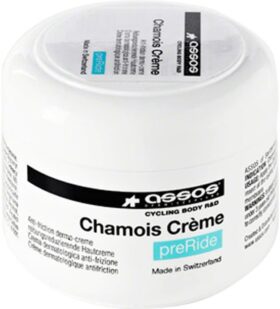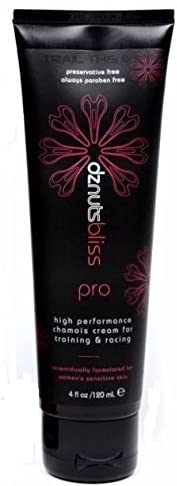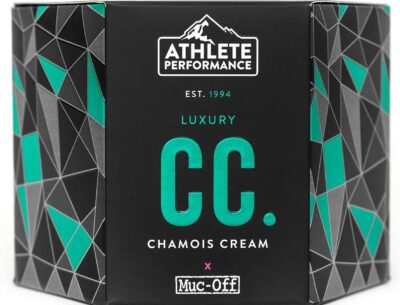Let’s talk about one of the taboo topics in cycling – chamois cream. Don’t worry if you have no idea what it is. Just know that it’s something you most certainly need if you bike frequently.
I’m sure that you have experienced slight to severe discomfort after sitting on the saddle for an extended period. And the one from the chafing caused by friction between the cloth and your thighs.
Chamois cream (or anti-chafing) cream is the one-stop solution to that problem. It’s a fantastic formula that reduces friction. And don’t worry about it being in your sensitive areas because the cream has anti-bacterial capabilities – at least ones from reputed companies do.
Even if you have those “leather thingies” in your bike shorts that prevent chafing or discomfort from the saddle, you’ll still need chamois cream to keep things going. Honestly, the name chamois cream is ambiguous because the cream, formula, and usage have evolved over the years. Let me explain.
Page Contents
What is chamois cream, and why do YOU need it?
During the 1940s, the original chamois cream was introduced when bikers who were using leather pads to prevent chafing started complaining about the pads getting hardened over time. The cream was periodically used to re-soften those pads.
Over the years, that chamois cream has evolved into one that’s applied to various parts of the body. Nowadays, it’s more commonly called anti-chafing cream because the usage is getting diversified. For example, hikers also use the cream to prevent discomfort and chafing caused by walking long distances.

So, what exactly is inside this cream, and how does it work?
According to Healthline, Chamois cream is a thick cream that minimizes friction between clothes and legs. This is done by creating a protective layer over the skin that helps to prevent discomfort caused by the uncomfortable rubbing against clothes or the saddle.
1. What does chamois cream contain? Is it safe?
While the complete list of ingredients varies between brands, most (reputable) chamois creams at least have the following ingredients: aloe vera, coconut oil, sunflower oil, shea butter, provitamins, witch hazel, green tea leaf extract, tea tree oil, and lavender oil.
Since the idea is to provide a thick protective layer, some brands also use mineral oil and propylene glycol to absorb water (in this case, sweat and moisture).
You cannot use most chamois creams “down there,” aka the sensitive area of your body, especially the ones with essential oils like tea tree oil and lavender oil. Although it isn’t the general criterion and varies among products. I recommend discussing it with your healthcare provider before using any chamois cream down there.
This is also why most doctors recommend applying chamois cream directly to your skin in specific areas instead of putting it on your chamois (bike shorts).
2. Primary Benefits of Chamois Cream
Chamois creams have tonnes of benefits, according to various doctors. Here are some of the major ones:
- Chamois creams are easily washable.
- It soothes irritated skin, relieves minor aches, and prevents major discomfort.
- It’s antibacterial, so it prevents a bacterial infection that might occur because of sweat.
- Chamois cream eliminates friction to prevent chafing.
3. Do YOU need to use it?
Benefits aside, chamois creams are still a chemical compound, so you should be very clear whether you actually need it or not.
Ideally, you shouldn’t wait for discomfort before using chamois cream, but you only need it for longer rides. If you’re facing any noticeable and regular discomfort (or chafing) on shorter rides, under 1-1.5 hours, then you need to change your chamois and get a new pair of bike shorts.
Top 4 Chamois Creams to Buy in 2022!
Here are the best chamois creams that you can buy in 2022:
1. Paceline Chamois Butt’r Original


Where To Buy
Paceline’s Chamois Butt’r Original is easily the most popular chamois cream in the market. The cream is non-greasy and free from any kind of paraben or gluten. Paceline did try to expand with other products like Butt’r Coconut, but Chamois Butt’r Original seems to be the better of the two, according to most users.
Buy Paceline Chamois Butt’r Original on Amazon
While Chamois Butt’r Original is a unisex chamois cream, Paceline has another women-specific product, Butt’r for Her, which has balanced pH levels making it ideal for sensitive skin.
2. Assoss Chamois Cream


Where To Buy
Assoss is a famous brand among bikers. Although, it’s slightly expensive than Paceline’s Butt’r Original and not as cost-effective. Assoss is known for making chamois cream. Assos chamois cream is made with 100% natural ingredients and doesn’t feel greasy when applied.
Assos cream is also known for its cooling and analgesic properties that give a refreshing feeling without acting as irritants.
4. dznuts Chamois Cream

Where To Buy
Like Paceline, dznuts also has a specific product for the female demographic. The dcnuts Women’s Bliss is a high-performance chamois cream with anti-chafing properties.
The cream claims to reduce saddle sores by a huge margin. You can also use it on wounds to soothe irritated skin and have healing properties.
Buy dznuts Women’s Bliss Chamois Cream on Amazon
Dznuts’ Men’s Pro chamois cream is made specifically for the male anatomy. While it has almost identical features (reduction of saddle sores, wound healing properties), it also helps prevent
Read More: Best Bike Computers in 2022 – An Odometer, A Speedometer & Much More
Buyer’s Guide: What to look for when buying chamois cream?
If you’re buying a chamois cream for the first time, you basically need to look at five primary factors – ingredients, type, need, compatibility, and net cost. Lemme explain in detail.
1. Know Thy Ingredients
Since you’ll be applying the cream directly on your screen, it’s pertinent that you know all the ingredients. Some chamois creams use natural ingredients, while others use synthetic products (Propylene Glycol) or petroleum-based mineral oil.
Of course, there’ll be some antifungal and antibacterial compounds paired with aloe vera and butter (mostly cocoa).
Tip: Don’t buy any chamois cream with methanol or mint or any other substance that gives a refreshing and tingling sensation if your skin is prone to redness and rashes. These compounds act as irritants if you have sensitive skin.
2. Usage – Current Discomfort & Chafing
Your current levels of discomfort and chafing will be super important for your final decision. For non-professionals who have chafing or discomfort in the prominent areas like thighs and buttocks can just go with the regular cream.
And if you’re a pro who has this issue all over the body, you should consider getting a stick-based chamois cream.
3. Application Style: Tub, Tube, or Stick
Chamois creams are categorized into three types based on application. The first type comes in a tub-like container, and you dip your fingers to apply the cream. The second is a tube that is relatively self-explanatory. The third is like a stick which you can rub on your body like deodorant.
Unless you’re a professional, you don’t need the stick-based cream.
As for the tub/jar one, its quality is that it’s a little watery, which people like a lot. But the entire method is unhygienic and just forget about double-dipping. That isn’t even an option. On the contrary, the tube option is pretty hygienic, but the cream inside is thicker.
4. Unisex or Gender-specific
Chamois cream formulas are made for three different categories – male, female and unisex. This is done by chemically constituting the cream with supplements that suit their individual anatomy well.

For example, you won’t find essential oils like lavender oil, tea tree oil, or similar products like methanol or mint. Even with their “refreshing” effect, these compounds are irritable and discomforting to women’s sensitive areas.
If you don’t wanna get into too many details, you can just buy the unisex cream.
5. Net Cost of Cream
I often talk about the cost of a product in a buyer’s guide because it’s obviously important to stay within your budget. But the situation this time is slightly different as chamois cream is a consumable product, unlike a bike helmet or mirrors.
With consumable products, you should look at the following cost – how much it costs you per use and how long the product lasts. I say this because some of the expensive chamois creams are more cost-effective than cheaper ones as they last for several months when used correctly.
How (& where) to correctly apply chamois cream?
1. How to correctly apply cream to chamois?
Step 1: Wash your hands with soap and water and turn the chamois inside-out.
Step 2: Take out a quarter-sized chamois cream and rub it between fingers to warm it up.
Step 3: Apply the cream to the seams of your chamois, especially around the parts that touch your nether regions and thighs.
Step 4: Let it dry up a bit before wearing the shorts. Meanwhile, apply the cream to your skin.
2. How to correctly apply chamois cream to the skin?
Apply it before any physical activity without a lot of gaps.
Step 1: Wash your hands with soap and water to ensure they’re as germ-free as possible.
Step 2: Take out a quarter-sized chamois cream and rub it between fingers to warm it up.
Step 3: Apply the cream to friction-prone areas such as your thighs, buttocks, nether regions, and even underarms. You can do it by massaging the cream onto the skin.
Step 4: Re-apply every few hours as required. Wash your hands properly with soap and water.
Read More: Best Stylish Bike Helmets for Men and Women To Buy in 2022
Common Chamois Cream Mistakes You Should Avoid
Here are the biggest mistakes everyone makes with their chamois cream or chamois:
1. Wearing undergarments
You aren’t supposed to wear undergarments under your chamois because it’s counterintuitive and defeats the purpose of wearing chamois in the first place.
Wearing undergarments prevents chamois from doing their job – trapping bacteria and reducing friction in your nether regions. In fact, wearing underpants further increases the risk of soreness and chafing.
2. Buying products with the wrong ingredients
If you have been following this guide properly, you should already know by now which ingredients you’re supposed to buy and which ones to avoid.
TL;DR: stay away from petroleum products and other “refreshing” products if you have sensitive skin.
3. Using way more cream than necessary
You’re only supposed to use a quarter-sized amount of chamois cream per application. Any more than that, and you fall into the category of misusing the cream or “overdoing” it, creating further problems.
Without delving too deep into the physics of it, let’s just say that using more cream than necessary ends up creating more friction.
4. Wearing double chamois
You’d be wrong to think that wearing doubling the chamois would double up the padding, which is good for you. If you notice carefully, any object needs to push against something to generate the necessary force for action. It’s high school science that we push the ground beneath us when walking.
Similarly, your buttocks shouldn’t be so far away from the saddle that your body has to use more force than necessary. This can further increase friction and cause saddle sores.
5. Doing everything wrong with your chamois
Ideally, I shouldn’t have to warn you that you shouldn’t wear wrong-sized chamois or wear chamois past expiration. It isn’t worth the money you’re saving. But we don’t live in an ideal world, do we?
Another major common mistake is washing the chamois incorrectly. For starters, wash your chamois inside-out with a soft skin-sensitive detergent. Finally, hang-dry it under the sun for UV exposure instead of putting it in the dryer.
Read More: How to fix a rusty bike chain? When to lubricate or replace?
Alternatives to Chamois Cream: Do they work well?
Yes, there are quite a few alternatives to chamois cream that could be used when you don’t have the cream in hand. Of course, you can use them as permanent replacements too, if they work well for you.

1. Can you use Vaseline or other products available at home?
You can use products like vaseline petroleum jelly or vaseline intensive care body gel available at your home as a replacement for chamois cream. If you don’t wanna use petroleum-based products, you can go with coconut oil, shea butter, or cocoa butter.
Do note that these home products and the commercial alternatives like Helene’s Cocoa Butter Creme don’t work as well as chamois cream as they don’t have the right balance between the required compounds. Moreover, these don’t wash off as quickly and smoothly as a chamois cream.
2. Does diaper cream work as well as chamois cream?
Diaper cream works well when you use it post-ride for relief and “healing,” but it won’t help during the ride. It’s because diaper cream has drying agents that would create more friction.
3. DIY: Can you make your own chamois cream formula?
You can DIY your own chamois cream using shea butter and coconut oil. Create the cream by mixing 4 ounces of shea butter for every 2 ounces of coconut oil. Although this is a basic recipe and won’t be anywhere as good as a chamois cream.
Not to worry, though, because you can check out DIY chamois recipes from professionals like coach Levi’s homemade chamois cream or Hannah Nicklin’s.
Frequently Asked Questions:
1. How long does chamois cream last?
Chamois cream tends to last for two to three years on a normal day before it breaks down and slowly becomes less effective. Although, the process speeds up during really hot days (because of sweat) and rainy days.
It’s advisable to use thicker creams (jar-based) on such days, so it doesn’t break down quickly.
2. How frequently should you apply chamois cream?
The frequency of reapplying chamois cream heavily depends on your physical activity (usage) and your skin’s sensitivity. Some people will need to reapply faster than others which is fine but don’t use any more than the quarter-sized amount to prevent unnecessary problems.
3. Should you carry it with you on the ride?
If you’re going on a multi-day trip, you’ll need to reapply chamois cream. Carry small plastic containers with yourself (or the cream tube) for such instances.
Happy biking!



